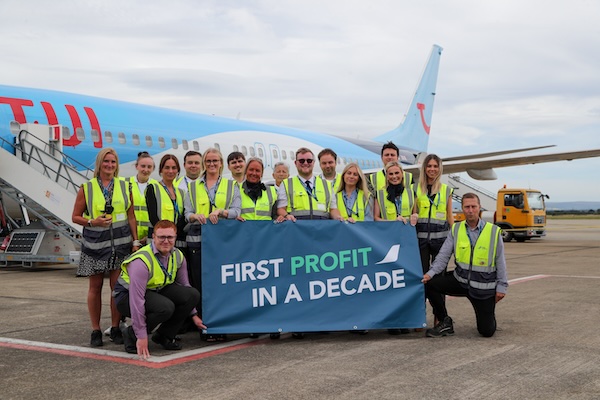Teesside Airport reports its first profit in over a decade, yet faces ongoing challenges. External factors such as supply chain disruptions are impacting growth.
A strategic review is underway to address these issues and align future plans with market demands, ensuring long-term sustainability.
Financial Performance and Challenges
Teesside Airport has achieved its first profit in over a decade, with earnings before interest, taxes, depreciation, and amortisation (EBITDA) totalling £308,555 on revenues of £14.5 million in the year ending March 2023. Despite this financial turnaround, the airport faces significant financial and operational challenges. These challenges are compounded by global supply chain issues and delays in new aircraft deliveries, which could hinder projected passenger growth.
The strategic review prompted by these circumstances will reassess the airport’s 10-year financial sustainability plan. Currently at its halfway point, the plan’s re-evaluation aims to align future strategies with evolving market demands and conditions. The review will be undertaken by a leading independent accountancy firm, known for its expertise in aviation and transportation sectors.
Operational Strategy and Market Response
In the wake of the financial profit, Teesside Airport is engaging in discussions with airlines to expand its route offerings. The conversations are part of a broader aim to sustain and enhance the airport’s market position despite the uncertainties surrounding the aviation industry.
Aviation industry experts highlight the need for a flexible and responsive operational strategy to navigate the complexities of global supply constraints and changing passenger preferences. This approach involves exploring partnerships with carriers to boost capacity and route networks, thereby solidifying the airport’s role as a regional transport hub.
Managing Director Phil Forster remains optimistic about these developments, stating, “We still face strong headwinds but continue to have positive discussions with airlines to grow the number of routes on offer.” His comments underscore the commitment to overcoming current obstacles and pursuing long-term growth.
Regional Impact and Economic Contributions
The positive financial results coincide with Tees Valley’s strategic initiatives to revitalize the local economy through the development of Teesside International Airport. This includes leveraging the airport’s business park to generate employment and attract investments.
Tees Valley Mayor Ben Houchen plays a pivotal role in this development. Houchen has emphasized the return to profitability as a fulfilment of his pledge when the region regained control of the airport. Besides reinstating popular holiday destinations, the ongoing business park expansion is seen as a cornerstone for local economic growth through the creation of well-paid jobs.
The airport’s rebound is deemed to be “well ahead” of financial expectations, serving as a catalyst for further investments and regional development. This momentum is anticipated to persist, driven by a combination of public and private sector initiatives aimed at sustaining the airport’s viability and enhancing its socio-economic impact.
Strategic Review and Future Planning
The strategic review’s primary objective is to ensure that Teesside Airport’s future planning is not only robust but also reflective of current and anticipated market dynamics. This involves a comprehensive analysis of strategic priorities, including infrastructure development, service diversification, and stakeholder engagement.
The review’s findings are expected to be instrumental in informing the airport’s future strategies, potentially leading to adaptations in its planning to better suit a post-pandemic aviation environment. This aligns with broader industry trends that demand resilience and adaptability from airports to thrive in a changing landscape.
Mayor Ben Houchen echoes the need for this strategic reassessment, stating, “It’s vital our plan is reviewed to reflect the new challenges and opportunities we face for us to continue to move forward on a sound financial basis.” His remarks reflect a proactive stance in reassessing and refining growth strategies.
Airline Partnerships and Route Development
Collaborations with airline partners are central to Teesside Airport’s growth objectives. The airport aims to incrementally increase its route offerings to attract more passengers and boost its market share within the region’s competitive aviation landscape.
These efforts are designed to not only grow passenger numbers but also to enhance customer satisfaction by offering a wider range of destinations. Such strategic partnerships are integral to the airport’s strategy to distinguish itself as a viable option for both leisure and business travellers.
Infrastructure and Service Enhancements
Infrastructure improvements and service enhancements remain core components of the airport’s strategy to appeal to a broader audience. Efforts to upgrade facilities and implement technology-driven solutions are key to providing a superior passenger experience and achieving operational efficiency.
The anticipated investments in infrastructure are aligned with the airport’s vision of becoming a modern and competitive transport hub. This focus is expected to attract additional airlines and routes, further embedding the airport’s role as a significant player in regional connectivity.
Community and Stakeholder Engagement
Teesside Airport continues to engage with community stakeholders to align its development goals with regional aspirations. This involves regular consultations and collaborations aimed at ensuring that the airport’s growth aligns with regional economic objectives and community expectations.
Teesside Airport’s transition to profitability marks a significant achievement, yet the journey ahead requires strategic agility and collaboration. By addressing financial, operational, and community challenges head-on, the airport can continue to build on its current momentum. The anticipated outcomes of the strategic review will likely chart a course towards sustained growth and stability, securing its role as a vital regional asset.

